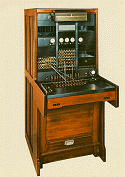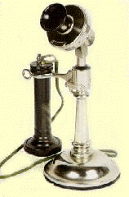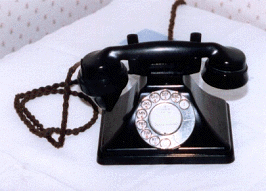| I have written about how farming was back then. This continues
the subject.
Almost no farms had telephones. The Rural Electrification
Act of 1936 in addition to allowing farmers to establish cooperatives to
provide electricity also provided that farmers could establish telephone
cooperatives. These cooperatives were permitted to borrow funds at
low interest rates and then pay off the loans with charges levied against
farmers who joined the cooperative and signed up for telephone service.
The cooperative had their own poles and lines down the roads in the country.
The farmer was responsible for stringing wire from the road to his house.
Farmers then began to have phones.
There were no dial phones. The phone was on the wall and
had a crank. The mouthpiece was firmly attached to the wall and the
ear piece was connected to the phone by a wire. To place a call you
picked up the ear piece from its cradle and turned the crank. This
let the switchboard operator know you were on the line. You didn’t
have to remember a lot of numbers you just said to the operator “Get me
the Owl drugs” or “Connect me with Raz Bilbrey” or the like. Things
in the towns were similar. If you had a phone it was usually a party
line. By this I mean there might be four homes on the same line each
with a different ring. When a call came in all four phones would
ring. Mine ring might be one short and one long. Yours might
be one long and one short. Another might be two shorts and the four two
long rings. All four could pick up and hear the conversation.
If you were polite even though you heard the ring if it was not your you
would not pick up the ear piece.
Back then many a girl got her first job as a telephone operator.
She was called Central. You would pick up the phone and she would
answer “Central, may I help you please” and you would say “let me have
Mary Smith”. The switchboard operator would then connect you with
Mary Smith. 
The switchboard had a pair of wires going into it for each telephone.
The wires ended in a jack. The operator had a cable with jacks at
each end. She would place one end of the plug in your jack and the
other end in Mary Smith's jack. There were lights by each jack.
When the light on your jack lit up as you called central the operator would
plug into your line to answer you. As she plugged it into Mary Smith’s
jack her jack light would glow. When you hung up the light would
go out and the operator would know to unplug the cable from your jack.

Later there were phones you did not have to crank. This was called
a candlestick phone.
Still later there were desk sets you had to dial.

And still later there were phones like we see today with buttons
we push.
In the earlier days after there became a larger number of telephone
users it became necessary for each telephone to have a number. I
remember as late as 1953 in a small town a number I called was 193J.
In the towns with larger populations and in the cities telephone
exchanges were established. Any one exchange could only have so many
numbers then another exchange was established. Your telephone number
would have two letters identifying the exchange and then five numbers.
There were still no area codes to dial. In 1950 in San Antonio I
recall calling LI43395 for the Lindale Exchange and AL54673 for the Alamo
Exchange. Probably the most famous exchange of all, which was not
in San Antonio, was PA. And the most famous number was 65000 ...
in other words, Pennsylvania six five thousand.
Later switchboards gave way to automation with rotary switches
and stepping relays taking the place of operators. Still later, all
the switching was and is done electronically.
Today you can still contact an operator by dialing 0 or 00 or
611, but if you are in Fort Worth that operator could be anywhere. |